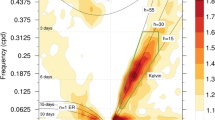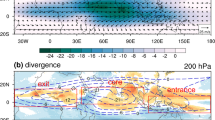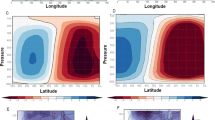Abstract
The influences of mesoscale eddies on variations of the Kuroshio path south of Japan have been investigated using time series of the Kuroshio axis location and altimeter-derived sea surface height maps for a period of seven years from 1993 to 1999, when the Kuroshio followed its non-large meander path. It was found that both the cyclonic and anticyclonic eddies may interact with the Kuroshio and trigger short-term meanders of the Kuroshio path, although not all eddies that approached or collided with the Kuroshio formed meanders. An anticyclonic eddy that revolves clockwise in a region south of Shikoku and Cape Shionomisaki with a period of about 5–6 months was found to propagate westward along about 30°N and collide with the Kuroshio in the east of Kyushu or south of Shikoku. This collision sometimes triggers meanders which propagate over the whole region south of Japan. The eddy was advected downstream, generating a meander on the downstream side to the east of Cape Shionomisaki. After the eddy passed Cape Shionomisaki, it detached from the Kuroshio and started to move westward again. Sometimes the eddy merges with other anticyclonic eddies traveling from the east. Coalescence of cyclonic eddies, which are also generated in the Kuroshio Extension region and propagate westward in the Kuroshio recirculation region south of Japan, into the Kuroshio in the east of Kyushu, also triggers meanders which mainly propagate only in a region west of Cape Shionomisaki.
Similar content being viewed by others
References
Akitomo, K., T. Awaji and N. Imasato (1991): Kuroshio path variation south of Japan. 1. Barotropic inflow-outflow model. J. Geophys. Res., 96, 2549-2560.
Chao, S. Y. and J. P. McCreary (1982): A numerical study of the Kuroshio south of Japan. J. Phys. Oceanogr., 12, 679-693.
Ebuchi, N. and K. Hanawa (2000): Mesoscale eddies observed by TOLEX-ADCP and TOPEX/POSEIDON altimeter in the Kuroshio recirculation region south of Japan. J. Oceanogr., 56, 43-57.
Ebuchi, N. and K. Hanawa (2001): Trajectory of mesoscale eddies in the Kuroshio recirculation region. J. Oceanogr., 57, 471-480.
Endoh, T. and T. Hibiya (2001): Numerical simulation of the transient response of the Kuroshio leading to the large meander formation south of Japan. J. Geophys. Res., 106, 26,833-26,850.
Feng, M., H. Mitsudera and Y. Yoshikawa (2000): Structure and variability of Kuroshio current in Tokara Strait. J. Phys. Oceanogr., 30, 2257-2276.
Hanawa, K. and H. Mitsudera (1985): On the data processing of daily mean value of oceanographic data.-Note on the daily mean sea-level data. Bull. Coastal Oceanogr., 23, 79-87 (in Japanese).
Ichikawa, K. (2001): Variation of the Kuroshio in the Tokara Strait induced by meso-scale eddies. J. Oceanogr., 57, 55-68.
Imawaki, S., M. Gotoh, H. Yoritaka, N. Yoshioka and A. Misumi (1996): Detecting fluctuations of the Kuroshio axis south of Japan using TOPEX/POSEIDON altimeter data. J. Oceanogr., 52, 69-92.
Kawabe, M. (1985): Sea level variations at the Izu Islands and typical stable paths of the Kuroshio. J. Oceanogr. Soc. Japan, 41, 307-326.
Kawabe, M. (1986): Transition processes between the three typical stable paths of the Kuroshio. J. Oceanogr. Soc. Japan, 42, 174-191.
Kawabe, M. (1988): Variability of Kuroshio velocity assessed from the sea-level difference between Naze and Nishinoomote. J. Oceanogr. Soc. Japan, 44, 293-304.
Kawabe, M. (1989): Sea level changes south of Japan associated with the non-large-meander path of Kuroshio. J. Oceanogr. Soc. Japan, 45, 181-189.
Kawabe, M. (1995): Variations of current path, velocity, and volume transport of the Kuroshio in relation with the large meander. J. Phys. Oceanogr., 25, 3103-3117.
Kawabe, M. (1996): Model study of flow conditions causing the large meander of the Kuroshio south of Japan. J. Phys. Oceanogr., 26, 2449-2461.
Kobashi, F. and H. Kawamura (2001): Variations of sea surface heights at periods of 65-220 days in the subtropical gyre of the North Pacific. J. Geophys. Res., 106, 26,187-26,831.
Kuragano, T. and M. Kamachi (2000): Global statistical spacetime scales of oceanic variability estimated from the TOPEX/POSEIDON altimeter data. J. Geophys. Res., 105, 955-974.
Kuragano, T. and A. Shibata (1997): Sea surface dynamic height of the Pacific Ocean derived from TOPEX/POSEIDON altimeter data: Calculation method and accuracy. J. Oceanogr., 53, 585-599.
Masuda, A. (1982): An interpretation of the bimodal character of the stable Kuroshio path. Deep-Sea Res., 29, 471-484.
Mitsudera, H., T. Waseda, Y. Yoshikawa and B. Taguchi (2001): Anticyclonic eddies and Kuroshio meander formation.Geophys. Res. Lett., 28, 2025-2028.
Qiu, B. and W. Miao (2000): Kuroshio path variations south of Japan: Bimodality as a self-sustained oscillation. J. Phys. Oceanogr., 30, 2124-2137.
Robinson, A. R. and B. A. Taft (1972): A numerical experiment for the path of the Kuroshio. J. Mar. Res., 30, 65-101.
Sekine, Y. (1990): A numerical experiment on the path dynamics of the Kuroshio with reference to the formation of the large meander path south of Japan. Deep-Sea Res., 37, 359-380.
Taft, B. (1972): Characteristics of the flow of the Kuroshio south of Japan. p. 165-216. In Kuroshio-Its Physical Aspects, ed. by H. Stommel and K Yoshida, University of Tokyo Press, Tokyo, Japan.
White, W. B. and J. P. McCreary (1976): On the formation of the Kuroshio meander and its relationship to the large-scale ocean circulation. Deep-Sea Res., 23, 33-47.
Yamagata, T. and S. Umatani (1989): Geometry-forced coherent structures as a model for the Kuroshio large meander. J. Phys. Oceanogr., 19, 130-138.
Yamashiro, T. and M. Kawabe (1996): Monitoring position of the Kuroshio axis in the Tokara Strait using sea level data. J. Oceanogr., 52, 675-687.
Yasuda, I., J. H. Yoon and N. Suginohara (1985): Dynamics of the Kuroshio large meander-Barotropic model. J. Oceanogr. Soc. Japan, 41, 259-273.
Yoon, J. H. and I. Yasuda (1987): Dynamics of the Kuroshio large meander: Two-layer model. J. Phys. Oceanogr., 17, 66-81.
Author information
Authors and Affiliations
Rights and permissions
About this article
Cite this article
Ebuchi, N., Hanawa, K. Influence of Mesoscale Eddies on Variations of the Kuroshio Path South of Japan. Journal of Oceanography 59, 25–36 (2003). https://doi.org/10.1023/A:1022856122033
Issue Date:
DOI: https://doi.org/10.1023/A:1022856122033




